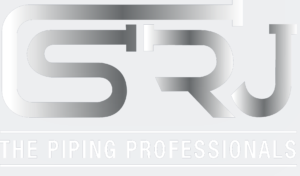
Components of a typical industrial chemical piping system
The Critical Role of Chemical Piping Systems
Chemical piping systems form the circulatory network of process industries, safely transporting aggressive fluids under varying temperatures and pressures. These specialized systems are engineered to handle corrosive, toxic, or otherwise hazardous materials while maintaining structural integrity and preventing environmental contamination.
At SRJ Piping India, we've designed chemical piping systems for diverse applications including:
- Pharmaceutical manufacturing
- Petrochemical processing
- Water treatment plants
- Food and beverage production
- Semiconductor fabrication
Key Considerations for Chemical Piping
- Chemical compatibility with piping materials
- Temperature and pressure requirements
- Flow characteristics and velocity limitations
- Expansion and contraction management
- Accessibility for maintenance and inspection
1. Material Selection for Chemical Piping
Choosing the right material is the foundation of any chemical piping system. The selection depends on the chemical properties of the fluid, operating conditions, and budget constraints.
Metallic Materials
- Stainless Steel (304/316): Excellent for most acids except hydrochloric
- Duplex Steel: Higher strength and corrosion resistance
- Hastelloy: For highly corrosive environments
- Titanium: Exceptional for chlorides and oxidizing acids
Non-Metallic Materials
- PVC/CPVC: Cost-effective for many acids at moderate temperatures
- PP/PE: Excellent chemical resistance, lightweight
- PVDF: High purity applications like semiconductors
- Fiberglass Reinforced Plastic (FRP): For highly corrosive environments
Our material selection service includes comprehensive chemical resistance testing to ensure optimal performance.
2. System Design Considerations
Proper design is crucial for safety, efficiency, and longevity of chemical piping systems. Key design factors include:
Hydraulic Design
Calculating proper pipe diameters to maintain optimal flow velocities (typically 1-3 m/s for chemicals) while minimizing pressure drop and erosion risks.
Thermal Considerations
Accounting for thermal expansion in high-temperature systems through expansion loops, bellows, or flexible piping sections.
Support and Anchoring
Proper spacing of supports to prevent sagging and vibration while allowing for thermal movement.

Critical elements in chemical piping system design
3. Installation Best Practices
Proper installation ensures system integrity and prevents premature failures. Our installation protocols include:
- Pre-installation Inspection: Verify material certificates and check for transport damage
- Proper Handling: Use nylon slings for non-metallic pipes to prevent surface damage
- Alignment: Avoid forced alignment that creates residual stresses
- Protection: Implement measures against UV degradation for outdoor plastic pipes
- Testing: Conduct hydrostatic tests and leak checks before commissioning
Learn more about our professional installation services for chemical piping systems.
4. Joining Methods and Techniques
The joining method significantly impacts system reliability and maintenance requirements:
| Method |
Best For |
Advantages |
Considerations |
| Welding |
Metallic systems, high pressure |
Strong, leak-proof |
Requires skilled labor, heat affected zone |
| Flanged |
Frequent maintenance areas |
Easy disassembly |
Potential leak points, heavier |
| Threaded |
Small diameter metallic pipes |
No special tools needed |
Not for cyclic services |
| Solvent Cement |
Thermoplastic systems |
Quick, economical |
Proper curing time critical |
| Mechanical Joints |
Large diameter pipes |
Field adjustable |
Regular inspection needed |
5. Maintenance and Inspection Protocols
Proactive maintenance prevents unexpected failures in chemical piping systems:
Routine Inspection Checklist
- Visual examination for leaks, corrosion, or damage
- Ultrasonic thickness testing for metallic pipes
- Support and hanger condition assessment
- Insulation integrity checks
- Flange bolt torque verification
Preventive Maintenance Strategies
Implement a comprehensive maintenance program including:
- Regular cleaning to prevent buildup
- Corrosion monitoring with coupons or probes
- Gasket and seal replacement schedules
- Valve exercising and lubrication
6. Safety Measures and Containment
Chemical piping systems require robust safety measures to protect personnel and the environment:
Essential Safety Features
- Secondary containment systems for leak detection
- Proper labeling with chemical identification and flow direction
- Emergency shut-off valves at strategic locations
- Pressure relief devices for overpressure protection
- Vent and drain provisions for safe maintenance
Our team specializes in designing fail-safe chemical piping systems that meet stringent safety regulations.
Industry Standards and Regulations
Chemical piping systems must comply with numerous international and local standards:
- ASME B31.3: Process Piping
- API 570: Piping Inspection Code
- ISO 15649: Piping - Pressure integrity
- OSHA 1910.119: Process Safety Management
- Local environmental regulations for chemical handling
SRJ Piping India maintains full compliance with all applicable standards for quality assurance in chemical piping projects.
Emerging Technologies and Trends
The chemical piping industry is evolving with new technologies:
Smart Monitoring Systems
IoT-enabled sensors for real-time corrosion monitoring, leak detection, and predictive maintenance.
Advanced Materials
Development of nanocomposite materials offering superior chemical resistance and mechanical properties.
Modular Construction
Prefabricated skid-mounted systems reducing installation time and improving quality control.
Ready to Optimize Your Piping System?
Our experts can design a customized solution tailored to your specific chemical handling needs.
Get a Free Consultation
Expert Q&A: Chemical Piping Systems
Q: How often should chemical piping systems be inspected?
A: The frequency depends on the chemical service, but most systems should have thorough inspections annually, with critical systems requiring quarterly checks. Our inspection team can help establish an appropriate schedule.
Q: What's the typical lifespan of a chemical piping system?
A: With proper material selection and maintenance, metallic systems can last 15-25 years, while high-quality plastic systems may last 10-15 years. Aggressive chemical services may require more frequent replacement.
Q: How do you handle chemical piping for high-purity applications?
A: High-purity systems require special materials like PVDF or electropolished stainless steel, orbital welding techniques, and rigorous cleaning protocols. We've completed numerous pharmaceutical-grade piping installations.


